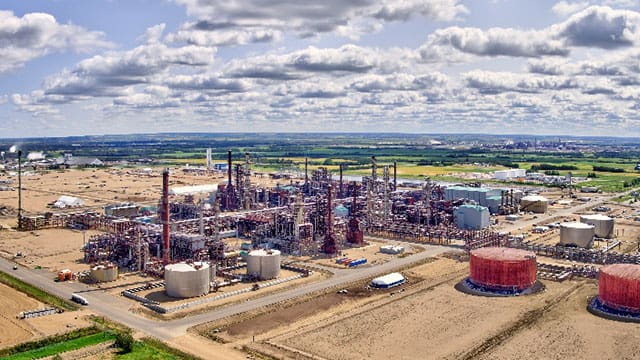The Sturgeon Refinery is a monument to Alberta’s financial mismanagement

For interview requests, click here
In January 2024, Premier Danielle Smith directed the Alberta Ministry of Energy to explore ways to reduce the province’s financial exposure in the Sturgeon Refinery, formally known as the North West Redwater Partnership (NWRP). This included the possibility of selling the government’s 50 per cent ownership stake. While options were expected to be presented in the spring, updates have yet to be provided.
The Sturgeon Refinery, which began commercial operations in June 2020, is jointly owned by Canadian Natural Resources Limited (CNRL) and the Alberta Petroleum Marketing Commission (APMC), a government agency. The facility processes 79,000 barrels per day of diluted bitumen into refined products like diesel and naphtha. Despite its operational success, Alberta’s financial exposure to the project has raised significant concerns.
The Alberta government’s exposure dates back to the project’s early stages. A December 2010 Cabinet report outlined terms allowing the province to withdraw at the project sanctioning stage if economic conditions made it unviable. Exiting at that point would have cost Alberta $200 to $300 million, plus an additional $50 million. However, the exit option was not exercised.
 The Sturgeon Refinery is a $28 billion financial burden for Alberta taxpayers. |
| Recommended |
| Promised tax cuts could drag Alberta into deficit chaos
|
| It’s time for a fiscal constitution in Alberta
|
| Long-term fiscal crisis looms in Alberta without immediate action
|
Warnings about financial risks were flagged early. A July 2010 Treasury briefing noted the agreement required Alberta to assume equity-like risks without equity-level returns. The province was locked into paying unconditional debt tolls for 30 years, regardless of whether the refinery was completed on time, operated efficiently, or achieved profitability.
By 2013, capital costs had escalated to $8.5 billion – well above the initial 30 per cent cap established in the agreements. Changes to the processing agreements (PAs) required APMC to cover 75 per cent of the $2.8 billion increase through higher toll payments, pushing the total cost of service tolls to nearly $25 billion over 30 years. APMC’s payments became unconditional, meaning the agency would bear the costs regardless of the refinery’s performance or profitability.
As of March 2024, Alberta’s future toll commitments total $37.3 billion, with APMC responsible for 75 per cent, or $28 billion, over the life of the project. In 2023/24 alone, APMC paid $930.7 million in tolls. A 2023 Auditor General report emphasized the significant risks tied to these obligations, noting that much of the debt repayment will not begin until 2032. By then, advancing decarbonization efforts and shifting market dynamics could further erode demand for the refinery’s products.
A 2015 Standard & Poor’s report highlighted the province’s exposure, noting that APMC and CNRL had assumed construction risks with no cap on project costs. This left Alberta vulnerable to escalating financial commitments without sufficient safeguards.
The 2021 Optimization Transaction aimed to reduce Alberta’s exposure, saving an estimated $2 billion in net present value over the project’s life. It also improved short-term cash flow by $1 billion over five years and eliminated tolling returns on equity, saving hundreds of millions. However, the agreement extended the debt repayment profile and toll obligations by an additional 10 years to 2058, further entrenching Alberta’s financial commitments. While these changes mitigated some risks, the underlying financial exposure remains significant. A July 2024 credit opinion from Moody’s noted the project’s weak economic rationale for toll payers unless margins significantly exceed toll costs.
Given these substantial risks, it is critical to explore viable solutions to reduce the financial burden on Alberta taxpayers. Selling the province’s 50 per cent equity stake poses significant challenges, as it would require a private buyer to take on $28 billion in toll obligations over the next 40 years. Other potential solutions include debottlenecking, which involves optimizing the refinery’s operations to process more bitumen. This could increase throughput, generate additional cash flow, and help reduce tolling burdens, thereby improving the refinery’s financial performance and alleviating some of Alberta’s financial exposure.
Current agreements allocate 75 per cent of profits from excess capacity to NWRP, with the remaining 25 per cent split between APMC and CNRL. Introducing stricter benchmarks for toll-eligible operating costs could also help manage expenses and alleviate toll pressures.
The Smith government must disclose the full range of options being considered and provide detailed long-term cash flow projections for each scenario. Taxpayers deserve clarity on the potential outcomes of Alberta’s multibillion-dollar investment in the refinery. The financial risks tied to the Sturgeon Refinery underscore the importance of robust risk management and transparent decision-making.
Despite efforts to mitigate exposure, Alberta remains heavily committed to a project with uncertain long-term returns. With an estimated $28 billion in toll obligations, the Smith government owes Albertans a clear explanation of its plans to address these challenges.
Whether Alberta retains its ownership or pursues alternative strategies, transparency and a concrete plan are urgently needed. Without these measures, taxpayers remain at significant financial risk in a project whose economic rationale continues to weaken.
Lennie Kaplan is a former senior manager in the Fiscal and Economic Policy Division of Alberta’s Treasury Board and Finance Ministry, where, among other duties, he assessed the risks of government financial arrangements with private sector business ventures. He also served as a research consultant to the Auditor General of Alberta’s 2018 audit entitled APMC Management of Agreement to Process Bitumen at the Sturgeon Refinery.
Explore more on Alberta’s Business, Alberta politics, Alberta debt and deficit, Smith government
Troy Media is committed to empowering Canadian community news outlets by providing independent, insightful analysis and commentary. Our mission is to support local media in building an informed and engaged public by delivering reliable content that strengthens community connections, enriches national conversations, and helps Canadians learn from and understand each other better.

